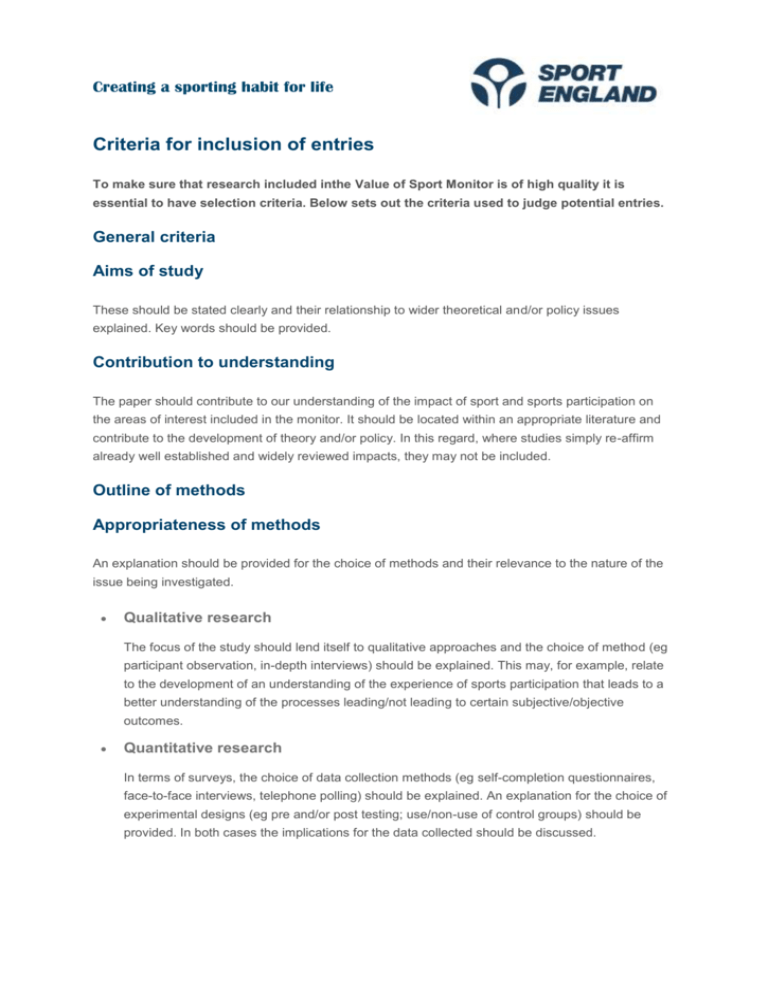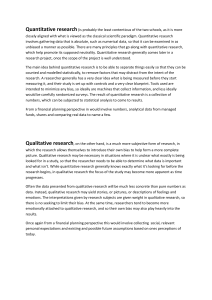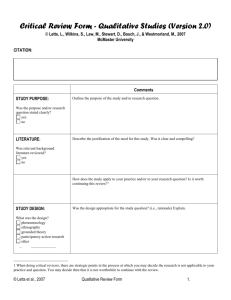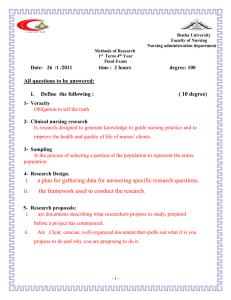Criteria for inclusion of entries
advertisement

Creating a sporting habit for life Criteria for inclusion of entries To make sure that research included inthe Value of Sport Monitor is of high quality it is essential to have selection criteria. Below sets out the criteria used to judge potential entries. General criteria Aims of study These should be stated clearly and their relationship to wider theoretical and/or policy issues explained. Key words should be provided. Contribution to understanding The paper should contribute to our understanding of the impact of sport and sports participation on the areas of interest included in the monitor. It should be located within an appropriate literature and contribute to the development of theory and/or policy. In this regard, where studies simply re-affirm already well established and widely reviewed impacts, they may not be included. Outline of methods Appropriateness of methods An explanation should be provided for the choice of methods and their relevance to the nature of the issue being investigated. Qualitative research The focus of the study should lend itself to qualitative approaches and the choice of method (eg participant observation, in-depth interviews) should be explained. This may, for example, relate to the development of an understanding of the experience of sports participation that leads to a better understanding of the processes leading/not leading to certain subjective/objective outcomes. Quantitative research In terms of surveys, the choice of data collection methods (eg self-completion questionnaires, face-to-face interviews, telephone polling) should be explained. An explanation for the choice of experimental designs (eg pre and/or post testing; use/non-use of control groups) should be provided. In both cases the implications for the data collected should be discussed. Creating a sporting habit for life Sampling Qualitative research Although samples do not need to be representative, nor random, there is a need for a rationale for selection, the provision of clear details of the nature and context of the sample and how it was recruited. Sample size can be justified on the basis of the aims of the study and the claims the authors wish to make about their findings and their generalisability. Quantitative research Where sampling has been used, details should be provided about the nature of the population from which the sample is drawn, the type of sampling (eg quota, purposive, simple random, stratified) and its strengths and weaknesses (this information should also be provided if secondary analysis of existing data is being undertaken). Data analysis Validity Qualitative research Comment should be provided as to the steps taken to address issues of validity – increasing the plausibility of the data and analysis; triangulation; inter-connectedness of various aspects of the data. If the researchers checked their interpretations with respondents details of how this was done and comments dealt with should be provided. Quantitative research An explanation should be provided as to how core categories were chosen and operationalised (eg intensity of participation in sport; self-esteem, fitness), the extent of conceptual and operational validity (eg content, criterion and construct) and the implications for findings. Reliability Qualitative research If reliability checks were possible some discussion should be provided. Quantitative research Some discussion of the reliability of the data, attempts to maximise this and the implications for the generalisability of findings. Sampling errors should be specified for both full sample analysis and any sub-sample analysis (eg minority ethnic groups, age categories, individual sports). Creating a sporting habit for life Analysis procedures and processes The processes and procedures for analysis should be detailed. The reader should be able to understand the processes or procedures or steps through which the data analysis evolved. Statistics Where measures of association or inferential statistics are used (for both experimental and survey work), an explanation for their choice should be provided. Where possible, the use and explanation of statistics should be as accessible as possible for a non-academic audience. Description of analytic framework An analytic framework should be outlined. In some cases there may be a pre-existing framework for data analysis and the derivation of this framework should be explained. If there is no pre-existing framework then an explanation for the rationale for the analysis strategy should be provided. Alternative explanations Where relevant, the researcher should consider alternative explanations for the results and possible different interpretations of the direction of causality Use of transcript excerpts When using quotes to highlight findings, the source of the excerpt should be referenced, and the basis for its selection explained (eg: are they representative, illustrative etc.) Findings and discussion Researcher impact For qualitative studies the researcher should clearly outline their role in the research process. They should provide some comment on their approach and how this might have influenced the results. Consistency The results should seem credible and appropriate, relating back to the research questions and located within the relevant literature. Where the paper has been of an exploratory nature, with the aim of using data analysis to inductively produce theory, then the pertinent literature can be outlined in the discussion section. Creating a sporting habit for life Theoretical considerations The claims made for theory development need to be consistent with the data presented. Generalisability Authors should comment on the extent to which their findings can be generalised, the limitations of the data and the extent to which it indicates a need for further research. Utilisation Ideally the findings should be useful and relevant to the development of policy. The author will provide added value by commenting on the policy and/or management implications.











